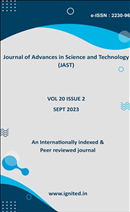A Study of Optimization of Smart Grid Power Flow.
DOI:
https://doi.org/10.29070/w1wg1v58Keywords:
Optimal Power Flow, power systems, Smart grids, technology, Renewable energyAbstract
Optimal Power Flow (OPF) is a fundamental concept in the management and operation of modern electrical power systems, particularly within the context of smart grids. As the demand for electricity continues to grow and the energy landscape evolves towards greater sustainability, the need for efficient, reliable, and adaptive power systems has become more critical than ever. The primary objective of OPF is to determine the most efficient way to operate the power system while satisfying various technical and operational constraints. This involves the optimization of several variables, including generator outputs, voltage levels, and power flows, to minimize costs, reduce losses, and enhance system reliability. Smart grids can enhance their resilience to disturbances, support the efficient use of renewable energy, and provide reliable electricity to consumers.
Downloads
References
Abdi, H., Beigvand, S. D., & La Scala, M. (2017). A review of optimal power flow studies applied to smart grids and microgrids. Renewable and Sustainable Energy Reviews, 71, 742-766.
Azizi, S, Salehi-Dobakhshari, A, Nezam-Sarmadi, S.A & Ranjbar, A.M 2012, ‗Optimal PMU Placement by an Equivalent Linear Formulation for Exhaustive Search‘, IEEE Trans. Smart Grid, vol. 3, no. 1, pp. 174-182.
Baldwin, T.L, Mili, L, Boisen, M.B & Adapa, R, 1993, ‗Power system observability with minimal phasor measurement placement‘, IEEE Transactions on Power Systems, vol. 8, no. 2, pp. 707-715.
Basetti, V & Chandel, A.K 2017, ‗Optimal PMU placement for power system observability using Taguchi binary bat algorithm. Measurement‘, vol. 95, pp. 8-20.
Cheng, W, Cheng, R, Shi, J, Zhang, C, Sun, G & Hua, D 2018, ‘Interval power flow analysis considering interval output of wind farms through affine arithmetic and optimizing-scenarios method’, Energies, vol. 11, no. 11, P. 3176
Duman, S, Rivera, S, Li, J & Wu, L 2020, ‘Optimal power flow of power systems with controllable wind-photovoltaic energy systems via differential evolutionary particle swarm optimization’, International Transactions on Electrical Energy Systems, vol. 30, no. 4, pp. 1-28.
Gopakumar, P, Chandra, G.S, Reddy, M.J.B & Mohanta, D.K 2013, ‗Optimal placement of PMUs for the smart grid implementation in Indian power grid—A case study‘, Frontiers in Energy, vol. 7, no. 3, pp. 358-372.
Ida Evangeline, S & Rathika, P 2021, ‘Real-time optimal power flow solution for wind farm integrated power system using evolutionary programming algorithm’, International Journal of Environmental Science and Technology, vol. 18, no. 7, pp. 1893-1910, Impact Factor: 2.860.
Jarrah, M., Jaradat, M., Jararweh, Y., Al-Ayyoub, M., & Bousselham, A. (2015). A hierarchical optimization model for energy data flow in smart grid power systems. Information Systems, 53, 190-200.
Kusakana, K 2015, ‘Optimal scheduled power flow for distributed photovoltaic/wind/diesel generators with battery storage system’, IET Renewable Power Generation, vol. 9, no. 8, pp. 916-924.
Li, S, Gong, W, Wang, L & Gu, Q 2022, ‘Multi-objective optimal power flow with stochastic wind and solar power’, Applied Soft Computing, vol. 114, Article no. 108045, pp. 1-17.
Mazhari, S.M, Monsef, H, Lesani, H & Fereidunian, A 2013, ‗A multiobjective PMU placement method considering measurement redundancy and observability value under contingencies‘, IEEE Transactions on Power Systems, vol. 28, no. 3, pp. 2136-2146
Muthukumaran, E., & Kalyani, S. (2021). Development of smart controller for demand side management in smart grid using reactive power optimization. Soft Computing, 25, 1581-1594.
Nazari-Heris, M & Mohammadi-Ivatloo, B 2015, Application of heuristic algorithms to optimal PMU placement in electric power systems: An updated review. Renewable and Sustainable Energy Reviews, vol. 50, pp. 214-228.
Pravina, P, Babu, MR & Kumar, AR 2021, ‘Solving optimal power flow problems using adaptive quasi-oppositional differential migrated biogeography-based optimization’, Journal of Electrical Engineering & Technology, vol. 16, no. 4, pp. 1891-1903.
Roy, R & Jadhav, HT 2015, ‘Optimal power flow solution of power system incorporating stochastic wind power using Gbest guided artificial bee colony algorithm’, International Journal of Electrical Power & Energy Systems, vol. 64, pp. 562-578.
Shao, C, Wang, X, Shahidehpour, M, Wang, X & Wang, B 2016, ‘An MILPbased optimal power flow in multicarrier energy systems’, IEEE Transactions on Sustainable Energy, vol. 8, no. 1, pp. 239-248
Sureshkumar, K., & Ponnusamy, V. (2020). Hybrid renewable energy systems for power flow management in smart grid using an efficient hybrid technique. Transactions of the Institute of Measurement and Control, 42(11), 2068-2087.
Tuttelberg, K & Kilter, J 2015, ‗Optimal placement of branch PMUs for specified redundancy and line observability‘, In Power & Energy Society General Meeting, pp. 1-5.
Vigliassi, M.P, London, J.B.A, Delbem, A.C.B & Piereti, S.A.R, 2017, ‗Combining multi-objective evolutionary algorithm and H Δ matrix for SCADA and PMU placement‘, In Power & Energy Society General Meeting, IEEE, pp. 1-5.
Walters, D.C. and Sheble, G.B., 1993. Genetic algorithm solution of economic dispatch with valve point loading. IEEE transactions on Power Systems, 8(3), pp. 1325-1332
Wang, C, Vittal, V& Sun, K 2011, ‗OBDD-based sectionalizing strategies for parallel power system restoration‘, IEEE Transactions on Power Systems, vol. 26, no. 3, pp. 1426-1433.
Wind Energy 2022, Available from: . 86. Yuan, X, Zhang, B, Wang, P, Liang, J, Yuan, Y, Huang, Y & Lei, X 2017, ‘Multi-objective optimal power flow based on improved strength Pareto evolutionary algorithm’, Energy, vol. 122, pp. 70-82.
Yuill, W, Edwards, A, Chowdhury, S & Chowdhury, S.P 2011, ‗Optimal PMU placement: A comprehensive literature review‘, In Power and Energy Society General Meeting, pp. 1-8.
Zehar, K & Sayah, S 2008, ‘Optimal power flow with environmental constraint using a fast successive linear programming algorithm: Application to the Algerian power system’, Energy Conversion and Management, vol. 49, no. 11, pp. 3362-3366.






